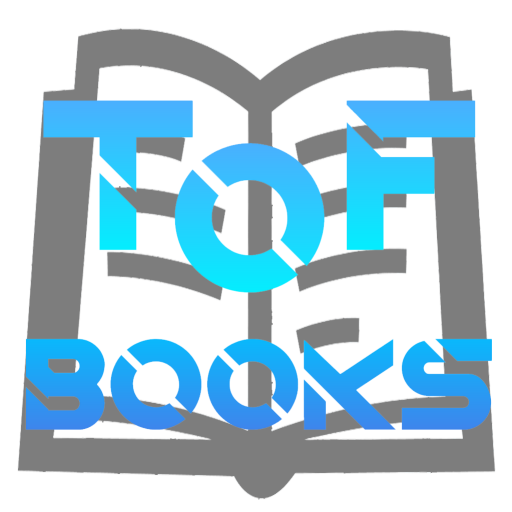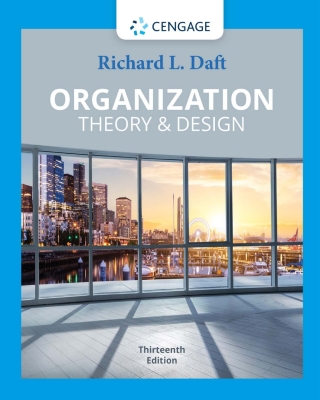Buy Organization Theory & Design, 13th Edition PDF ebook by author Richard L. Daft – published by Cengage Learning in 2021 and save up to 80% compared to the print version of this textbook. With PDF version of this textbook, not only save you money, you can also highlight, add text, underline add post-it notes, bookmarks to pages, instantly search for the major terms or chapter titles, etc.
You can search our site for other versions of the Organization Theory & Design, 13th Edition PDF ebook. You can also search for others PDF ebooks from publisher Cengage Learning, as well as from your favorite authors. We have thousands of online textbooks and course materials (mostly in PDF) that you can download immediately after purchase.
Note: e-textBooks do not come with access codes, CDs/DVDs, workbooks, and other supplemental items.
eBook Details:
Full title: Organization Theory & Design, 13th Edition
Edition: 13th
Copyright year: 2021
Publisher: Cengage Learning
Author: Richard L. Daft
ISBN: 9780357141595, 9780357141618
Format: PDF
Description of Organization Theory & Design, 13th Edition:
Discover the most progressive thinking about organizations today as acclaimed author Richard Daft balances recent, innovative ideas with proven classic theories and effective business practices. Daft’s best-selling ORGANIZATION THEORY AND DESIGN presents a captivating, compelling snapshot of contemporary organizations and the concepts driving their success. Recognized as one of the most systematic, well-organized texts in the market, the 13th edition of ORGANIZATION THEORY AND DESIGN helps both future and current managers thoroughly prepare for the challenges of today’s business world. This revision showcases some of the most current examples and research alongside time-tested principles. Readers see how many of today’s well-known organizations thrive amidst a rapidly changing, highly competitive international environment. New learning features provide opportunities for readers to apply concepts and refine personal business skills and insights.Important Notice: Media content referenced within the product description or the product text may not be available in the ebook version.
Table of Contents of Organization Theory & Design, 13th Edition PDF ebook:
About the AuthorBrief ContentsContentsPrefacePart 1: Introduction to OrganizationsChapter 1: Organizations and Organization Design1.1 A Look Inside General Electric1.2 Organization Design in Action1.3 What Is an Organization?1.4 Dimensions of Organization Design1.5 The Evolution of Organization Design1.6 The Contrast of Organic and Mechanistic Designs1.7 The Emerging Bossless Design Trend1.8 Framework for the BookChapter 1 Workshop: Measuring Dimensions of OrganizationsCase for Analysis: Craft Originalities, Inc.Part 2: Organization Purpose and Structural DesignChapter 2: Strategy, Organization Design, and Effectiveness2.1 The Role of Strategic Direction in Organization Design2.2 Organizational Purpose2.3 Two Frameworks for Selecting Strategy and Design2.4 Assessing Organizational Effectiveness2.5 An Integrated Effectiveness ModelChapter 2 Workshop: Identify Your Goal PreferencesCase for Analysis: The Addlington Gallery of ArtCase for Analysis: Millier Machine Parts & ServicesChapter 3: Fundamentals of Organization Structure3.1 Organization Structure3.2 Information-Sharing Perspective on Structure3.3 Organization Design Alternatives3.4 Functional, Divisional, and Geographic Designs3.5 Matrix Structure3.6 Virtual Network Structure and Outsourcing3.7 Holacracy Team Structure3.8 Applications of Structural DesignChapter 3 Workbook: You and Organization StructureCase for Analysis: Holtzclaw Supermarkets, Inc.Case for Analysis: Aquarius Advertising AgencyPart 3: Open System Design ElementsChapter 4: The External Environment4.1 The Organization’s Environment4.2 The Changing Environment4.3 Adapting to Complexity and Dynamism4.4 Framework for Adapting to Complexity and Dynamism4.5 Dependence on Financial Resources4.6 Influencing Financial Resources4.7 Organization-Environment Integrative FrameworkChapter 4 Workshop: Organizations You Rely OnCase for Analysis: CPI CorporationCase for Analysis: Farrington Medical DevicesChapter 5: Interorganizational Relationships5.1 Organizational Ecosystems5.2 Resource Dependence5.3 Collaborative Networks5.4 Population Ecology5.5 InstitutionalismChapter 5 Workshop: The ShamatosiCase for Analysis: Technomagia and AUDCase for Analysis: Bradford Chemicals CompanyChapter 6: Designing Organizations for the International Environment6.1 Entering the Global Arena6.2 The Challenges of Global Design6.3 Designing Structure to Fit Global Strategy6.4 Additional Global Coordination Mechanisms6.5 The Transnational Model of OrganizationChapter 6 Workshop: Made in the U.S.A.?Case for Analysis: Halogen AnalyticsCase for Analysis: Rhinebeck IndustrialChapter 7: Designs for Societal Impact: Dual-Purpose Organizations, Corporate Sustainability, and Et7.1 Designing the Dual-Purpose Organization7.2 Corporate Social Responsibility7.3 The Consequences for Doing Good7.4 Designing a Structure for Executing a Sustainability Program7.5 Designs to Uphold Ethical Values7.6 Corporate Ethics in a Global EnvironmentChapter 7 Workshop: What Is Your Level of Ethical Maturity?Case for Analysis: Solo: Helping a Million People See AgainCase for Analysis: Fiedler, Philips & Wilson DesignPart 4: Internal Design ElementsChapter 8: Designs for Manufacturing and Service Technologies8.1 Core Manufacturing Technology8.2 Surviving Extremely Complex Technologies8.3 Core Service Technology8.4 Noncore Departmental Technology8.5 Workflow Interdependence among DepartmentsChapter 8 Workshop: Small Business Workflow TechnologyCase for Analysis: Acetate DepartmentCase for Analysis: Digitalization in the Manufacturing Sector: Skills in TransitionChapter 9: Designs for Digital Organizations and Big Data Analytics9.1 The Digital Information Explosion9.2 Pipes versus Platforms: A New Organization Form9.3 Big Data Analytics9.4 Artificial Intelligence9.5 Other Digital Applications in Organizations9.6 Digital Impact on Organization DesignChapter 9 Workshop: Manufacturing and Big Data: Organize the ProjectCase for Analysis: Hermitage Escalator CompanyChapter 10: Organization Size, Life Cycle, and Decline10.1 Organization Size: Is Bigger Better?10.2 Organizational Life Cycle10.3 Organizational Size, Bureaucracy, and Control10.4 Bureaucracy in a Changing World10.5 Bureaucracy and Other Forms of Control10.6 Organizational DeclineChapter 10 Workshop: Classroom ControlCase for Analysis: Yahoo!: “Get to Work!”Case for Analysis: Bachmeyer Foods, Inc.Part 5: Managing Dynamic ProcessesChapter 11: Organizational Culture and Control11.1 Organizational Culture11.2 Culture and Organization Design11.3 Culture Strength and Organizational Subcultures11.4 Culture and Performance11.5 The Cultural Focus of Control SystemsChapter 11 Workshop: Balanced Scorecard ExerciseCase for Analysis: Midwest Controls, Inc.Case for Analysis: NASCARChapter 12: Innovation and Change12.1 The Strategic Role of Innovation12.2 Elements for Successful Change12.3 Technology Innovation12.4 New Products and Services12.5 Strategy and Structure Change12.6 Culture Change12.7 Tactics for Implementing ChangeChapter 12 Workshop: Innovation ClimateCase for Analysis: Fabulous FootwearCase for Analysis: Lamprey, Inc.Chapter 13: Decision-Making Processes13.1 Types of Decisions13.2 Individual Decision Making13.3 Cognitive Biases13.4 Organizational Decision Making13.5 Organizational Decisions and Change13.6 Contingency Decision-Making Framework13.7 Special Decision CircumstancesChapter 13 Workshop: Style of Decision MakingCase for Analysis: Government DTSCase for Analysis: Dubois French EateryChapter 14: Conflict, Power, and Politics14.1 Interdepartmental Conflict in Organizations14.2 Power and Organizations14.3 Political Processes in Organizations14.4 Using Soft Power and PoliticsChapter 14 Workshop: How Do You Handle Conflict?Case for Analysis: East Tennessee NewsCase for Analysis: The Burlington PlantIntegrative CasesIntegrative Case 1.0: Disorganization at Semco: Human Resource Practices as a Strategic AdvantageIntegrative Case 2.0: Walmart’s Failures in Entering Three Developed MarketsIntegrative Case 3.0: IKEA: Scandinavian StyleIntegrative Case 4.0: Engro Chemical Pakistan Limited-Restructuring the Marketing DivisionIntegrative Case 5.0: The New York Times versus AmazonIntegrative Case 6.0: Lean Initiatives and Growth at Orlando Metering CompanyIntegrative Case 7.0: SCG Lampang: Overcoming Community Resistance to a Sustainability Project (A)Integrative Case 8.0: Costco: Join the ClubIntegrative Case 9.0: The Donor Services DepartmentIntegrative Case 10.0: Cisco Systems: Evolution of StructureIntegrative Case 11.0: ToolTopia.comIntegrative Case 12.0: Sometimes a Simple Change Isn’t So SimpleGlossaryName IndexCorporate Name IndexSubject Index





